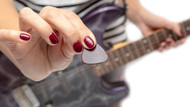Guitar Pick Guide 101: Choosing The Best Pick for Beginners
May 12th 2024

Guitar Pick Guide 101: Choosing The Best Pick for Beginners
The guitar pick, or plectrum, is a tool in almost every guitarist’s gig bag. While some musical styles like flamenco and classical music lend themselves to finger-picking, a pick allows for the precision, fullness and punch that gives rock, county, folk and jazz their distinct tone. They also help forge the connection between guitarist and instrument — even if you do occasionally drop them into the sound hole or the couch cushions.
Like with guitar strings, the guitar pick you use will affect how you play and how each note sounds. If you’re new to playing guitar, though, you may not want to use the same pick style as someone who has 10 or 20 years of shredding under their belt. The experts at Strings and Beyond are here to help you pick (rim shot) the right beginner guitar pick for months or even years of great playing. We’ll go over thickness, materials and other things to look at when choosing a guitar plectrum.
Guitar Pick Thickness
This is the number one factor when selecting a guitar pick. While there are dozens of industry-standard guitar pick thicknesses — and some manufacturers have come up with their own — they fall into four basic categories:
- Thin guitar picks: Anything less than 0.6mm thick.
- Medium guitar picks: Between 0.6mm and 0.8mm thick.
- Heavy guitar picks: Between 0.8mm and 1.2mm thick.
- Extra-heavy guitar picks: Anything more than 1.2mm thick.
Generally, thinner picks have a brighter sound and are better for strumming; heavier picks have a darker sound with more control for single strings. We recommend beginners use a thin or medium guitar pick. Thin picks make it easy to get the hang of rhythm strumming while medium picks are a versatile option that can do strumming or single-string picking.

Guitar Pick Shapes and Sizes
When shopping for your first guitar pick, you’ll find plenty of shapes. From triangle picks and Jazz III picks to shark fins, pentagons and thumb picks, there’s a lot to sort through.
For beginners, though, you should use one of two shapes. The standard guitar pick is just that: the most common plectrum shape around. By taking a basic heart shape and giving it rounded sides and corners with a triangular tip, you get a pick that works very well with traditional pick grips. They are sometimes called 351 picks because the Fender 351 developed in the 1950s was the first pick to use this shape.
The other good option is the teardrop pick. It’s like a standard guitar pick but with straighter sides and more rounding on the top. This makes them easier to grasp, especially if you have smaller hands — though you’ll have less control of the attack level.
As for the size, you should pick something that feels comfortable in your hand while still leaving enough of the tip available to pluck or strum without rubbing your hand on the string. A medium-size guitar pick is usually a good choice, but you might prefer a larger or smaller pick depending on how big your hands are.

Guitar Pick Material
Like with thickness and shapes, there are many different guitar pick materials, including Delrin, acrylic, metal, polycarbonate and carbon fiber. Beginners, though, should usually choose plastic celluloid or nylon picks. Celluloid picks are known for their balanced tone and reasonable amount of flex, which are good for guitarists who are mastering the basics. They’re also the most inexpensive pick available, so if you lose a few in the laundry or your vehicle seat, it’s not the end of the world. Nylon picks have a warmer sound and last longer than celluloid, but feel smoother and thus can be a little harder to grip.
The Music You Play
While the type of music you’re into is the least important consideration when selecting a beginner guitar pick, it’s work talking about. Smaller picks let you play faster and more precisely, which is better for jazz and metal. You can get picks with textured grips for this purpose, too. Larger picks work better for slower strumming and pick slides. A more rounded tip produces a mellower tone and softer attack while a sharper tip gives you a brighter tone and harder attack.
When to Replace Guitar Picks
Your guitar pick will eventually wear out, especially if you’re playing a lot. Here are a few signs that it’s time to ditch a guitar pick:
- The tip is significantly more rounded than when you started using it.
- The pick has bent significantly.
- It feels a lot smoother or slicker in your hand (this is especially true with textured picks).
- The edges have become jagged or uneven.
- Your strings are buzzing a lot more than usual and you haven’t changed your string gauge or action.

Changing Guitar Pick Types
Just because a certain guitar pick is best for getting started doesn’t mean you should use the same pick for the rest of your musical life. As you learn different techniques and your tastes change, you should consider changing picks or adding a new style to your arsenal. Many professional guitars keep several types of guitar picks handy to switch as needed — one pick for folk strumming, another for classic rock cord picking, a third for thrash metal, etc.
In the end, you should use a pick that offers the best combination of helping you play the music you like and feeling comfortable in your hand. We have hundreds of guitar pick styles in stock, and two picks from different manufacturers can feel different even if they’re the same thickness, shape, material and size. Since picks are one of the most inexpensive music accessories around, you can experiment with spending a lot of money.

